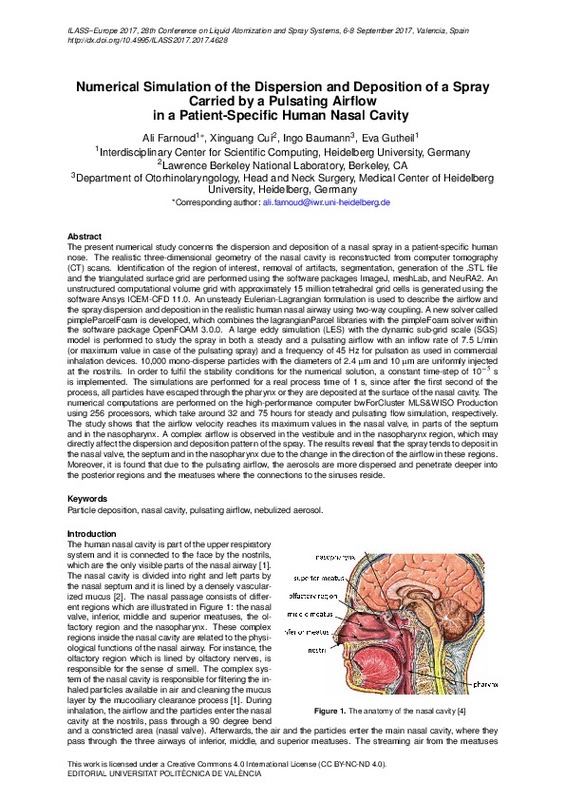JavaScript is disabled for your browser. Some features of this site may not work without it.
Buscar en RiuNet
Listar
Mi cuenta
Estadísticas
Ayuda RiuNet
Admin. UPV
Numerical Simulation of the Dispersion and Deposition of a Spray Carried by a Pulsating Airflow in a Patient-Specific Human Nasal Cavity
Mostrar el registro sencillo del ítem
Ficheros en el ítem
| dc.contributor.author | Farnoud, Ali
|
es_ES |
| dc.contributor.author | Cui, Xinguang
|
es_ES |
| dc.contributor.author | Baumann, Ingo
|
es_ES |
| dc.contributor.author | Gutheil, Eva
|
es_ES |
| dc.date.accessioned | 2018-03-29T09:41:31Z | |
| dc.date.available | 2018-03-29T09:41:31Z | |
| dc.date.issued | 2017-07-28 | |
| dc.identifier.isbn | 9788490485804 | |
| dc.identifier.uri | http://hdl.handle.net/10251/99926 | |
| dc.description.abstract | [EN] The present numerical study concerns the dispersion and deposition of a nasal spray in a patient-specific human nose. The realistic three-dimensional geometry of the nasal cavity is reconstructed from computer tomography (CT) scans. Identification of the region of interest, removal of artifacts, segmentation, generation of the .STL file and the triangulated surface grid are performed using the software packages ImageJ, meshLab, and NeuRA2. An unstructured computational volume grid with approximately 15 million tetrahedral grid cells is generated using the software Ansys ICEM-CFD 11.0. An unsteady Eulerian-Lagrangian formulation is used to describe the airflow and the spray dispersion and deposition in the realistic human nasal airway using two-way coupling. A new solver called pimpleParcelFoam is developed, which combines the lagrangianParcel libraries with the pimpleFoam solver within the software package OpenFOAM 3.0.0. A large eddy simulation (LES) with the dynamic sub-grid scale (SGS) model is performed to study the spray in both a steady and a pulsating airflow with an inflow rate of 7.5 L/min (or maximum value in case of the pulsating spray) and a frequency of 45 Hz for pulsation as used in commercial inhalation devices. 10,000 mono-disperse particles with the diameters of 2.4 µm and 10 µm are uniformly injected at the nostrils. In order to fulfil the stability conditions for the numerical solution, a constant time-step of 10−5 s is implemented. The simulations are performed for a real process time of 1 s, since after the first second of the process, all particles have escaped through the pharynx or they are deposited at the surface of the nasal cavity. The numerical computations are performed on the high-performance computer bwForCluster MLS&WISO Production using 256 processors, which take around 32 and 75 hours for steady and pulsating flow simulation, respectively. The study shows that the airflow velocity reaches its maximum values in the nasal valve, in parts of the septum and in the nasopharynx. A complex airflow is observed in the vestibule and in the nasopharynx region, which may directly affect the dispersion and deposition pattern of the spray. The results reveal that the spray tends to deposit in the nasal valve, the septum and in the nasopharynx due to the change in the direction of the airflow in these regions. Moreover, it is found that due to the pulsating airflow, the aerosols are more dispersed and penetrate deeper into the posterior regions and the meatuses where the connections to the sinuses reside. | es_ES |
| dc.description.sponsorship | The authors thank Dr. H. Mentzel from PARI Respiratory Equipment, Inc. for intense discussions about the pulsating spray initial conditions. The current study is part of a project supported by the German Research Foundation (DFG) through a research fellowship of the HGS MathComp. Furthermore, high-performance computing time at the bwForCluster MLS&WISO Production which is funded by the state of Baden-Württemberg through bwHPC and DFG through grant INST 35/1134-1 FUGG. | es_ES |
| dc.format.extent | 8 | es_ES |
| dc.language | Inglés | es_ES |
| dc.publisher | Editorial Universitat Politècnica de València | es_ES |
| dc.relation.ispartof | Ilass Europe. 28th european conference on Liquid Atomization and Spray Systems | es_ES |
| dc.rights | Reconocimiento - No comercial - Sin obra derivada (by-nc-nd) | es_ES |
| dc.subject | Particle deposition | es_ES |
| dc.subject | Nasal cavity | es_ES |
| dc.subject | Pulsating airflow | es_ES |
| dc.subject | Nebulized aerosol | es_ES |
| dc.title | Numerical Simulation of the Dispersion and Deposition of a Spray Carried by a Pulsating Airflow in a Patient-Specific Human Nasal Cavity | es_ES |
| dc.type | Capítulo de libro | es_ES |
| dc.type | Comunicación en congreso | es_ES |
| dc.identifier.doi | 10.4995/ILASS2017.2017.4628 | |
| dc.relation.projectID | info:eu-repo/grantAgreement/Baden-Württemberg Landesregierung//INST 35%2F1134-1 FUGG/ | |
| dc.rights.accessRights | Abierto | es_ES |
| dc.description.bibliographicCitation | Farnoud, A.; Cui, X.; Baumann, I.; Gutheil, E. (2017). Numerical Simulation of the Dispersion and Deposition of a Spray Carried by a Pulsating Airflow in a Patient-Specific Human Nasal Cavity. En Ilass Europe. 28th european conference on Liquid Atomization and Spray Systems. Editorial Universitat Politècnica de València. 529-536. https://doi.org/10.4995/ILASS2017.2017.4628 | es_ES |
| dc.description.accrualMethod | OCS | es_ES |
| dc.relation.conferencename | ILASS2017 - 28th European Conference on Liquid Atomization and Spray Systems | es_ES |
| dc.relation.conferencedate | September 06-08,2017 | es_ES |
| dc.relation.conferenceplace | Valencia, Spain | es_ES |
| dc.relation.publisherversion | http://ocs.editorial.upv.es/index.php/ILASS/ILASS2017/paper/view/4628 | es_ES |
| dc.description.upvformatpinicio | 529 | es_ES |
| dc.description.upvformatpfin | 536 | es_ES |
| dc.type.version | info:eu-repo/semantics/publishedVersion | es_ES |
| dc.relation.pasarela | OCS\4628 | es_ES |
| dc.contributor.funder | Deutsche Forschungsgemeinschaft | |
| dc.contributor.funder | Baden-Württemberg Landesregierung |








